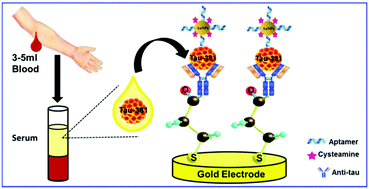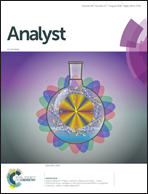A novel electrochemical aptamer–antibody sandwich assay for the detection of tau-381 in human serum
Abstract
Tau protein plays a crucial role in the pathogenesis of Alzheimer's disease (AD). However, the assay to detect low concentrations of tau protein is a great challenge for the early diagnosis of AD. We will outline a novel aptamer–antibody sandwich assay based on an electrochemical biosensor for the detection of tau-381 in human serum. To improve the detection sensitivity, the aptamer–antibody sandwich assay for the detection of tau-381 was developed by using a tau antibody (anti-tau) and an aptamer specific to tau-381 as the recognition element and cysteamine-stabilized gold nanoparticles (AuNPs) for signal amplification. Differential pulse voltammetry (DPV) was employed to record the signal response of tau-381 with different concentrations. The tau-381 concentration ranged from 0.5 pM to 100 pM. The responses of DPV measurements showed excellent results in this dynamic range. This simple, rapid, highly sensitive and specific assay gave a low limit of detection (LOD) of 0.42 pM for tau-381. The feasibility and reliability of the assay were verified by testing tau-381 in human serum from patients with AD. Thus, this method could prove valuable in diagnosing AD within the early stages of the disease.



 Please wait while we load your content...
Please wait while we load your content...